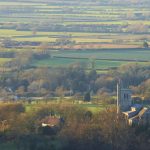Harvest is complete. It’s a smaller, quieter affair than when this farm grew acres of wheat and barley. Now, instead of grain, new hay fills the barn ready for the horses. The more unusual crops of yellow rattle and foxglove seeds are being sieved by hand.
The nearby meadow offers the next harvest of the year, but this one does not require humans. Here, a mix of seeds including teasels, cereals and sunflowers will instead be foraged by birds as the days shorten.
I reach out to stroke a whiskered triticale – a wheat-rye hybrid. Its coarse hairs tickle, and I notice a brown nodule, like a distorted grain protruding from the ear of grains. It looks like maybe a bird dropping or an odd, misshapen variation. It’s a sclerotium of ergot, which is a fungal disease that grows on rye and less commonly on grasses and wheat. Airborne spores have infected the floret, creating this seemingly innocuous abnormality.
In fact, ergot contains lysergic acid, from which LSD is manufactured. If eaten, it can create a severe reaction known as St Anthony’s fire, with burning sensations, fiery hallucinations, spasms and fatality. Ergot levels are strictly controlled by mills today, with stringent testing.
However, in the Middle Ages, it was often consumed, especially in times of famine. Some historians believe ergot played an overlooked role in history, suggesting that it could have been involved in the peculiar behaviours leading to the Salem witch trials of 1692. When Russia tried to capture ports from Turkey in the late 1700s, the hay and bread were both contaminated, leading to illness for soldiers and horses. The weakened army was forced into retreat. Another theory posits that, following a poor harvest, increased consumption of ergot influenced the mental state of French peasants, thus provoking the French revolution in 1789.
The triticale on the farm is not for human consumption and birds simply ignore it, so ergot here is not a concern. Instead, it’s an opportunity to ponder the vast, history-changing impact of failing to understand the interaction between us and our environment.
Country diary is on Twitter at @gdncountrydiary











